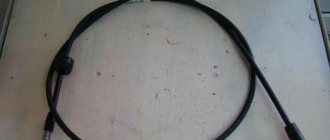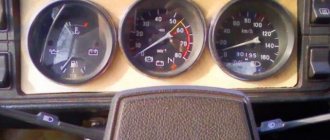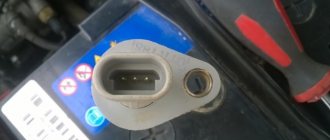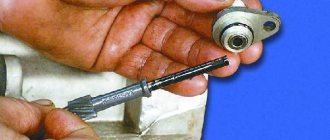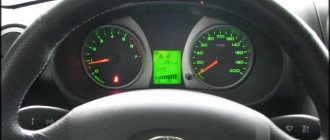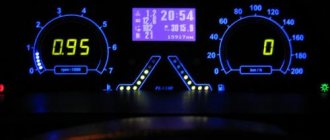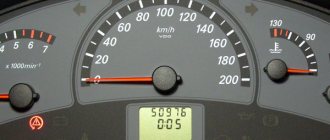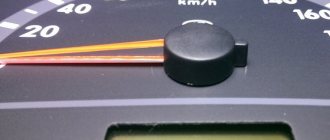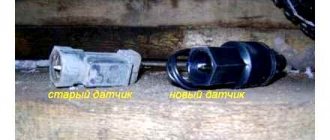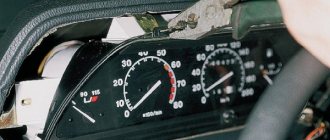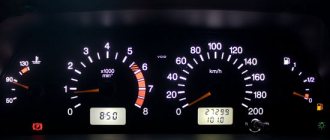As a rule, in most cars the main instruments are considered to be the speedometer, tachometer, and engine temperature gauge. The speedometer shows the speed of the car, the tachometer indicates the engine speed, and the temperature sensor determines the degree of heating of the coolant.
At the same time, many car owners lose sight of another important device - the mileage meter or odometer. Moreover, many people mistakenly believe that the speedometer and odometer are a single device. In fact, the odometer is only combined with the speedometer and is a separate device. Read more in our article.
Car odometer: what is it?
The dashboard of a modern car, of course, cannot be compared with the dashboard of an airplane, however, it can confuse an inexperienced driver. The speedometer, tachometer, odometer and other instruments and indicators, while certainly necessary and important, still require an explanation of their functions and their purpose. In this article we will talk about what a car odometer is, what they are, and also say a few words about how and why the readings of these devices are distorted.
Why do you need an odometer in a car?
The main task of the odometer is to show the total mileage of the car. This figure is important when buying or selling a vehicle.
On the dashboard you can see not one, but two odometers - one counts the total mileage, and the second - the daily mileage. The total cannot be reset, but the daily allowance can be reset very easily.
Many novice motorists ask a lot of questions about why even count the number of kilometers traveled by a car. Is this meaning really that important?
Odometer readings are used in the following cases:
- When buying or selling a car. The numbers on the instrument panel will tell you about the technical condition of the car’s chassis and engine;
- Fuel consumption. If you reset the readings on the daily odometer and fill up a full tank of gasoline or a full cylinder of gas, the driver can accurately determine the car’s appetite for 100 km;
- The distance between populated areas or any other points.
The daily odometer readings are useful for those who drive on second-generation gas - this is how and only this way you can determine the amount of gas in the cylinder. Also, the numbers will be important for those who earn money from car mileage.
Kinds
Auto control panel It’s not difficult to wind up or twist the mileage of your car. This is confirmed by numerous photos and videos that can be found on the Internet. Rolling a car's mileage allows it to increase its value on the market, so rolling is a common practice among resellers. But in order to wind up and roll up the mileage, you need to know exactly what type of device is used in the car.
The odometer programmer must be used in accordance with the type of device. And the type of device, in turn, may differ depending on the model of the vehicle and its year of manufacture. In total, there are three types of devices:
- Mechanical - this type is one of the oldest. Winding up the odometer can be done using any twister. The rotation of the car wheel is taken into account using a counter, in particular, the mechanical component. Under the influence of mechanical forces, the meter reads revolutions and converts them into mileage.
- Electronic-mechanical devices are a more advanced version of the devices described above. In this case, the odometer correction is carried out using CAN knobs. The counter reads wheel revolutions using mechanical links, but subsequently all this information is converted into signals. As a result, the data will be sent to the dashboard.
- The digital version on a microcontroller is currently the most modern. In this case, all the necessary indicators are read and converted into visible parameters in digital form. In this case, the speedometer correction is carried out using special equipment, since such a device is usually a component of the car’s on-board computer (the author of the video is BORAUTO Group).
What is a speedometer
A speedometer is a device that measures the instantaneous speed of a vehicle. The meter readings are displayed in km/h (kilometers per hour) or - in America - miles per hour. There are two types of speedometers: mechanical (analog), digital. How does the speedometer work and what does it show? In a rear-wheel drive car, the speedometer controls the rotation of the secondary shaft at the gearbox, in this case the speed is calculated from it. Accordingly, the speed readings will depend on the tire size, the gear ratio of the rear axle, as well as the device’s own error. For front-wheel drive vehicles, speed is measured using the left wheel drive. The curvature of the road adds to the speedometer error. We looked at the odometer and speedometer above (the difference is what they are used for, principles of operation). Let us now find out the reasons for speedometer errors.
Mechanical
How can you tell if the odometer has been corrected mechanically? In this case, winding up the odometer can be carried out even by a car enthusiast who has no experience in this process. If you adjusted the odometer yourself, it will be quite difficult to identify this later.
But the car owner can always diagnose the mounting of the device drive. If the place of fixation itself is clean, this means that everything is fine with the device, but if dirt is visible around, this indicates that the nut was unscrewed at one time.
Why is the speedometer lying?
If you look at a car's speedometer, it's not hard to guess why it's lying. Why does it show the speed limit? Firstly, the driver has less chance of breaking the speed limit and getting a fine. Secondly, if the speedometer indicated a lower speed than the real one, then, most likely, drivers would not stop suing automakers, proving their innocence of speeding. Does the speedometer have to lie? The fact is that this device is the most difficult to provide super-accurate readings, because the speed depends on the rotation of the wheel, on its diameter, and this is a very unstable parameter.
The speedometer error at a speed of 60 km/h is very minimal, it is practically non-existent. At a speed of 110 km/h, the error may be 5-10 km/h. If a car reaches a speed of up to 200 km/h, then the average error can be up to 10%. We have answered your question “what are odometer and speedometer”. The difference is now clear. Let's summarize. All of the above makes it possible to draw the following conclusions.
How does an odometer work on a car?
What does a mechanical odometer look like on the dashboard?
There are only three types of odometers:
- mechanical;
- electronic-mechanical;
- electronic;
Mechanical odometers are more than simple. There is a cable that connects to the output shaft of the gearbox, there is a mechanical counter with several, usually five, drums, to which the rotation of the cable is transmitted through a special mechanism. The reels are marked with numbers from which the odometer readings are compiled.
In electronic-mechanical odometers, the rotation of the cable is recorded using an electronic counter. Well, in purely electronic odometers there is no cable at all. Instead, Hall sensors or other electronic components are used to calculate the distance. Moreover, in the case of an electronic odometer, the readings are recorded by the on-board computer of the car. Such systems are considered the most accurate and reliable, but even they allow a measurement error of as much as five percent.
What does an electronic odometer look like on the dashboard?
The reasons for the distortion of odometer readings may be different. For example, this is wheels slipping when they rotate, but the car stands still. And although such moments make up a tiny part of the overall performance of the car, with high mileage values, they can contribute to distortion of the odometer readings.
Another reason for inaccuracies in the readings of such devices is tires with a size different from the one for which the odometer is designed.
Well, perhaps the most important reason for distortions in a car’s mileage may be intentional corrections of the odometer readings , and we’ll talk about them.
Design and principle of operation
It is common to think that the odometer can count kilometers traveled. In fact, the device measures the number of revolutions of the car's wheels as it moves. Probably everyone could observe different mileage at the same distance, but with different wheel diameters.
The odometer is designed as follows:
- Mechanical counter or electronic display - elements allow you to read data from the instrument panel;
- A counter or sensor that counts wheel revolutions;
- A controller inside of which, according to special algorithms, wheel revolutions turn into kilometers.
The device itself can be mechanical or electronic. The wheel can make an exact number of revolutions for every kilometer. Moreover, this indicator will be the same under different conditions. If the device knows exactly the number of revolutions per kilometer, then it is quite capable of calculating the distance traveled.
The mechanical odometer is driven by a flexible cable - it is made of a tightly coiled spring. Often, the cable is located inside a metal tube, which, in turn, is located in a rubber casing.
To operate the mechanism, the cable is connected on one side to the output shaft of the gearbox, and on the other side to the dashboard. There the cable is connected to the input shaft at the odometer.
Several worm gears are used inside the mechanical device. In general, the gear ratio is 1690:1.
The input cable causes the first worm gear to rotate - one revolution can turn the gear only one tooth. The same mechanism causes the next gear to rotate, which drives the next one.
Each mechanical type indicator has a row of pins that stick out from one side. There is also a set of two pins that are sharpened from the arc side.
When two pins are connected to a gear, one tooth is caught between the pins and can rotate with the indicator until the pins move further. In this mechanism, one of the pins also works, there are a larger number and performs 1/10 of the love spell.
Now, it’s probably clear and understandable why when the odometer shows between 19,999 and 20,000, the number “2” is somewhere in the middle, and not on a common level with the other numbers. The fact is that the device uses small pins that prevent the entire digital row from being in the same position. Often, for this reason. In order for all the numbers to be in an even row, the device must show 21,000.
As for electronic odometers of modern cars, everything is much more complicated. Everyone had or has a bicycle with a computer. So, a magnet is attached to the wheel of such a bicycle, and a reed switch is attached to a fixed part, for example, on a fork. When the magnet passes near the reed switch, the computer counts the rotation of the wheel, and then the information on the display is updated.
The car uses a system similar to a bicycle. Of course, the car owner will not find a magnetic sensor on the wheel - instead, you can see a toothed gear on the output shaft of the gearbox. A special sensor counts pulses when a gear tooth passes by it.
In some car models you can see a slot wheel and optical sensors - such an implementation is found in a computer mouse. The car's computer knows how far the car will travel between pulses and updates the odometer based on these numbers.
One of the interesting things about the modern odometer has to do with how the mileage data gets displayed on the instrument panel. The cable that was in the mechanical sensor is not here at all. The instrument panel receives information from the ECU through electronic circuits.
In this case, the car can be compared to a local network. Most machines use standard communication protocols - for example, SAE J1850. Thanks to them, all electronic systems and devices in the car can communicate and exchange data between devices.
The car's ECU takes into account each impulse and monitors the total distance the car has traveled during its life.
There is an opinion among experts that it is more difficult to sell a car with an electronic odometer - it is difficult to twist it back. It is easy to change the numbers on the dashboard, but it is very difficult to deceive the ECU, gearbox unit or other systems.
Distortion of real indicators
Rewinding odometer readings using a drill
As mentioned above, the odometer reading is an indicator of the condition of the car. There are life situations when it is necessary to adjust the results of the device after replacing large components of the car. Unfortunately, unscrupulous sellers often use twisting of the device to change the odometer readings to reduce the actual mileage of the car. True, there is such a thing as “rewinding the odometer,” when the results are increased. The easiest way to change the results is with a mechanical odometer; here it is enough to remove the instrument cable from the gearbox, connect an electric drill or electric motor to it, and then “rewind” the indicators to the desired result. This method of twisting the odometer is also suitable for the hybrid version of the device. The electronic odometer cannot be changed so easily, since it is part of the car’s on-board computer and the readings are transmitted not only to the display, but also to other vehicle control systems. So how to reset an electronic odometer? For this, there are both special programs and twisting devices.
What does the odometer measure?
Electronic odometer on the dashboard. Below is the total mileage, at the top is the daily mileage, on the right is a button to reset the daily mileage.
If the speedometer measures the speed at which the car is currently moving, then the odometer shows the number of kilometers the car has traveled. Translated from Greek, odo means road, and meter means to measure. So in the end we get a kind of “road meter”.
The odometer counts the kilometers traveled by counting the number of wheel rotations. Typically this device has two types of readings. The total mileage of the car, here we count every kilometer traveled by the car from the moment it left the assembly line, as well as the so-called daily mileage. It is called a daily allowance rather arbitrarily. In essence, you press a button, reset the readings of this scale, after which you can see the mileage of any segment of the route that you have covered over a period of time. Well, this figure is usually called the daily rate by taxi drivers, which is where the name comes from.
Indication error
The odometer is not an accurate measuring instrument. It has errors, just like the speedometer. Today there are entire standards for these same errors. It is believed that a mechanical odometer has an error of 5% to 15%.
If the car is operated mostly in harsh conditions, then the errors may be larger.
It must be taken into account that the sensor counts wheel revolutions, which means that the error increases due to wear of components and mechanisms, wear of tires and other systems. Slipping also affects the error - the car does not move, but the odometer counts.
The readings can be affected by gaps, loose springs, and poor grip. The electromechanical system reads the signals that the ECU sends in one unit of time.
In this case, the percentage of error will be negligible. But on average, the error of an electromechanical device is more than 5%, and the error of an electronic odometer is less than 5%.
Device types
At the dawn of the development of the automotive industry, only mechanical odometers were installed on cars. With the development of electronics, starting from the middle of the last century, electronic-mechanical devices appeared. On modern cars, mainly electronic odometers are installed and they are displayed on the dashboard, as a rule, in the form of a separate display.
Mechanical
The simplest to manufacture and most reliable mechanical devices. In them, mileage calculation was carried out by transmitting the rotations of a gear installed on the secondary shaft of the gearbox (its speed corresponds to the speed of rotation of the wheels) through a special cable to a roller with a set of numbers in the speedometer block. A significant drawback of such an odometer was that at some point the numbers ran out and it was reset to zero. It was impossible to determine the total mileage of the car, unless, of course, to record the number of “zeros.” And if he wanted to twist his testimony, it was also not difficult for an unscrupulous owner. These devices also suffered from inaccurate readings, which directly depended on the diameter of the wheels used - it had to be strictly calculated.
Semi-electronic
It was precisely in order to establish a record of the total mileage of a vehicle and to complicate the possibility of “twisting” the readings that semi-electronic odometers were developed. In them, the mechanical rotations of the same cable are converted by an induction unit into electromagnetic signals, which are then read by an electronic display and an on-board computer, in which all the data is stored. In such devices, it is already more difficult to change the readings, because you need to rewrite the records of the storage medium, but, unfortunately, there are already skilled people for such unjust deeds. Moreover, many websites have been created on the Internet, such as “odometer.rf,” offering such services, advertising such an operation as very simple. Although this is not true, because to get to the mileage records on all electronic units, in addition to skill, you will also need a significant amount of time.
Electronic
More advanced odometers are electronic. In them, the mechanical parts are replaced with Hall sensors, which convert the rotation of the secondary shaft into electromagnetic pulses, which are then read by electronic devices. Their readings are the most correct, they are distributed and stored in different electronic units of the car, so getting to them to change records is even more difficult.
What types of designs are there?
There are three main types of odometers: mechanical, electronic-mechanical, electronic.
- Mechanical odometers: purely mechanical designs that use the principle of mechanical transmission at all stages of recording the vehicle's mileage. The weak point of this rather reliable device was the mechanical counter. Consisting of 5 drums with numbers printed on them, it had limitations on the readings on the scale: having reached the maximum, the device was “reset to zero”. The percentage of error in the mechanical odometer readings is also quite high: it can reach 10%.
- Electronic-mechanical odometers: combine the features of hybrid devices. Thus, the transmission of torque also occurs through a cable connecting the gearbox shaft to the counter. However, the recording and processing of rotational movements is carried out by the counter in electronic format. This, however, did not eliminate the risk of reading error - up to 5%.
- Electronic odometers: operate like a microcontroller. The most modern devices. All necessary indicators are read in digital format. To correct such an odometer, you will need to use special equipment. An electronic odometer is part of the vehicle’s on-board computer, the most reliable and accurate.
[custom_ads_shortcode1]
Why do they rewind the odometer readings, how is it done?
When buying a used car, people are primarily interested not so much in the year of manufacture as in its mileage. No one wants to purchase a heavily used vehicle, such as in a taxi.
Therefore, some enterprising car enthusiasts rewind the odometer readings in the opposite direction in order to sell the car at a higher price. Sometimes the odometer readings are also “twisted” on a company car that has been used for other purposes.
“Rewinding” the readings occurs using a computer, in more rare cases – mechanically (on older car models).
Twisting odometer readings is a real business that has been successfully operating and developing for a long time. Even on YouTube you can find many tutorials and videos explaining the twisting process for various odometers.
Very often, the service of rewinding the distance counter of cars is modestly called “mileage correction.” Thus, sellers protect themselves from law enforcement agencies. After all, the service is illegal.
By the way, when buying fairly old cars, almost all buyers understand that the readings of the so-called mileage counter in the car have been twisted. Of course, this is taken into account when bidding.
Key aspects
As we have already said, winding up the odometer is a frequently encountered procedure, in particular during pre-sale work. Correcting the odometer readings makes it possible to demand more money for the car, which, naturally, is beneficial for every car owner who decides to sell his car. In order to track mileage, special equipment is even used to adjust odometers, for example, the 5 pro twister. But how can you understand that the device has been manipulated?
[custom_ads_shortcode1]
Odometer and speedometer: difference between devices
As already mentioned, not all car enthusiasts understand the difference between two different devices - an odometer and a speedometer. Some people are misled by the fact that the mileage counter is directly built into the speedometer itself. That is why many people classify this design as one device. What is it - an odometer and a speedometer? The difference between the functionality is obvious. It is simply unacceptable to confuse these devices. To be brief:
- The speedometer shows the speed of the vehicle.
- The odometer indicates the distance traveled in kilometers.
Their functionality is not interconnected in any way. The combination of these two scales on the dashboard is determined only by ease of perception by the driver. However, modern on-board computers display this information on the display among the main information.
Why do they twist the mileage?
“I twisted the speedometer to reduce mileage” is also a wrong expression among motorists. We explained what both the odometer and speedometer are used for. The difference and the photos of these devices indicate that in order to reduce the mileage, the readings of the odometer, rather than the speedometer, are adjusted. Why do they do this? Everyone justifies these desires differently. Device malfunction, replacement of the entire panel, driving on non-standard tires. To be honest, the reason is practically the same - everyone wants to “rejuvenate” their vehicle. This often happens when selling a car. There are also those who want, on the contrary, to increase their mileage. Often these are commercial vehicle drivers who use their cars for business purposes. After all, very often fuel consumption exceeds the standards allowed by accounting, which do not take into account depreciation and wear and tear of the vehicle. To compensate for these costs, drivers resort to such tricks as increasing mileage.
What's the difference between odometer and speedometer?
The main difference between an odometer and a speedometer is that, despite receiving data from one sensor and being integrated in one device, they measure different quantities: the first, based on the number of revolutions of rotation of the secondary shaft of the gearbox, calculates the distance traveled by the car, the second, based on the intensity of this rotation movement - its speed. They also differ in the value of their testimony. They are most significant in the odometer. After all, it is the mileage that determines the specific fuel consumption, technical condition, degree of wear of components and assemblies, the remaining engine life and, ultimately, the cost of a used car. That is why the desire of unscrupulous sellers to twist his testimony is so great. Many ways have also been found to doubt their reliability.
When buying a used car, a car enthusiast should be wary of the low mileage given its advanced age, while taking into account the average annual mileage of around 15,000 km (in large cities such as Moscow and St. Petersburg and even more - up to 25,000). There are also many external signs that do not confirm low mileage, such as:
- abrasion of the steering wheel,
- the driver's seat has been sat out and its upholstery is worn out,
- depression of the floor under the driver,
- excessive wear and tear of the paintwork on the pedals and their rubber pads,
- excessive use of brake linings or the presence of new ones, given that they are replaced every 50,000 km.
Any of them should suggest the need for a technical examination of the car by professionals. Therefore, with all the variety of instruments, the most significant in any vehicle is the odometer.
Summary
So, we found out how the odometer works, what it is and what types it is. This is a necessary thing in a car. You can do a lot with it. The odometer allows you to accurately determine when to change the oil and will also help you determine your fuel consumption.
Sources
- https://AvtoNov.com/%D0%BE%D0%B4%D0%BE%D0%BC%D0%B5%D1%82%D1%80-%D0%B0%D0%B2%D1%82% D0%BE%D0%BC%D0%BE%D0%B1%D0%B8%D0%BB%D1%8F-%D1%87%D1%82%D0%BE-%D1%8D%D1%82% D0%BE-%D1%82%D0%B0%D0%BA%D0%BE%D0%B5/
- https://AutoVogdenie.ru/chto-takoe-odometr.html
- https://FB.ru/article/284290/chto-takoe-spidometr-i-odometr-raznitsa-mejdu-priborami
- https://DriverTip.ru/osnovy/chto-takoe-odometr-v-avtomobile.html
- https://www.syl.ru/article/293369/odometr-chto-eto-takoe-printsip-deystviya-pokazaniya-korrektirovka
- https://kak-nazyvaetsya.ru/texnika/kak-nazyvaetsya-schetchik-kilometrazha.html
- https://dorpex.ru/avtomobilnyie-sovetyi/osnovyi-i-znaniya/odometr-naibolee-znachimyiy-pribor-v-avtomobile
